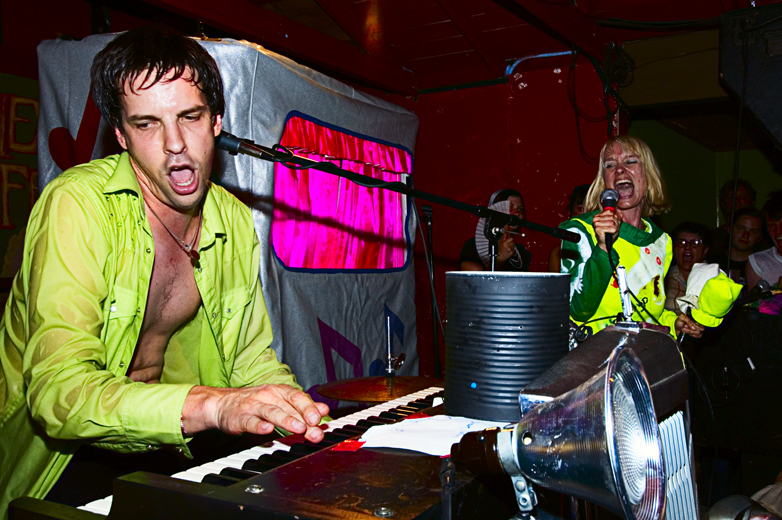
Quintron and Miss Pussycat perform at the Che Cafe. Photo by Lawrence Braun.
Quintron and Miss Pussycat is a music band and performance troupe founded in the late 1990s. The group is known for its eclectic “Swamp tech” music and its patented “Drum Buddy” synthesizer. They can often be seen at Quintron’s underground club, the Spellcaster Lodge, which is located on St. Claude Avenue (Eccentric New Orleans, “Mr. Quintron.” http://www.eccentricneworleans.com/mr__quintron.htm).
Performances
The eccentricity and intimacy of Quintron and Miss Pussycat’s performances are demonstrated by almost every aspect of their shows. First of all, the music itself is so unique that it merits its own genre. Andy Hermann, a writer from the local entertainment guide Metromix, has described their music as “part ‘Pee-wee’s Playhouse,’ part ‘Jon Spencer-meets-B-52s'” (Hermann, Andy. Metromix: Twin Cities, “Q&A: Quintron and Miss Pussycat: Talking Ducks, Puppets, and Drum Buddies with New Orleans’ ‘Swamp Tech’ Duo.” Last modified May 26, 2010). However, Quintron himself likes to call his music “swamp-tech”, which might be a reference to the many swamps found throughout Louisiana (Hermann). The “Drum Buddy” is featured in all of Quintron and Miss Pussycat’s shows and has become an indispensable part of the Quintron and Miss Pussycat musical experience.
What makes these unusual performances so intimate is that Quintron and Miss Pussycat go out of their way to include the audience in their performances. For example, when the band played a song called “Swamp Buggy Badass” at DC9 in Washington, D.C., Quintron extended his microphone to the crowd and encouraged individual audience members to sing their own lyrics. At Voodoo Fest 2011, Miss Pussycat decided to jump off stage in the middle of a song and dance with audience members while singing. Later, she even invited audience members on the stage to dance along with back-up dancers! (Personal observation by Sasha Silberberg Tulane University, June 2011).
NOMA Exhibit
From January 2009 through May 2010, the New Orleans Museum of Art (NOMA) presented Parallel Universe: Quintron and Miss Pussycat Live at City Park. This exhibition included Quintron’s recording studio, Quintron’s inventions and instruments, and a collection of Miss Pussycat’s handmade puppets, which she sometimes uses in mini puppet shows prior to their performances (Pais, Noah. “Life From NOMA: Quintron and Miss Pussycat, Icons of the Crescent City Underground, Prepare to Bring Their Art and Style to the New Orleans Museum of Art.” Gambit New Orleans News and Entertainment, sec. News, January 18, 2010). At the time of the exhibition, Quintron was in the process of creating another album and decided to use NOMA as a recording studio, allowing viewers to have a behind-the-scenes look into how Quintron makes his music. Additionally, viewers saw and interacted with Quitron’s musical invention, the “Drum Buddy”, which is a light-activated oscillating drum machine (Pais).
Another part of the exhibition included Miss Pussycat’s handmade puppets. These puppets have been used in short puppet shows to preface several of their musical performances. These shows may contain bewildering scenes about “secret pizza”, bizarre stories about Santa Claus murdering a witch, or anything in between. However, these puppets are also used outside of their performances. Miss Pussycat’s puppets are featured in some of the band’s albums and even have their own “puppet soap opera”, Trixie and the Treetrunks (Dainer-Best, Rachel. Fabric Magazine, “Not Your Usual Museum Fare: Miss Pussycat and Quintron’s ‘Parallel Universe’.” Last modified January 19, 2010). This entire exhibition gave viewers a more intimate perspective of the band, allowing them to see the work that goes into their performances and outside projects such as Miss Pussycat’s Trixie and the Treetrunks or Quintron’s “Drum Buddy”. In this way, NOMA provided the New Orleans community with a three month pass into the lives of Quintron and Miss Pussycat.
An Audience Member’s Perspective
Jeff Todd Titon, a professor of music at Brown University, has highlighted the significance of this type of relationship between musical performances and the surrounding community as a “music-culture model”. In this model, Titon claims that it is the community support that “usually influences the future direction of a particular kind of music” (Jeff Todd Titon, Worlds of Music: An Introduction to the Music of the World’s Peoples, (Belmont, CA: Schirmer Cengage Learning, 2009), 15-17). The effects of their performances on audience members illustrate this notion. In one interview with Jason Simon, a Tulane student from Louisiana who attended their show at Voodoo Fest in October of 2011, he explained how Quintron and Miss Pussycat’s performances contribute to the New Orleans community. According to Simon, this contribution is all about the band’s “carefree attitude” that they share with “a lot of New Orleanians” that attend their shows (Interview with Jason Simon, Tulane University, December 2011). He claims that their main goal is that “they [just] want you to have a good time with them” and this means that their performances are more “about the closeness of the community and everyone having fun together [than anything else]”.






